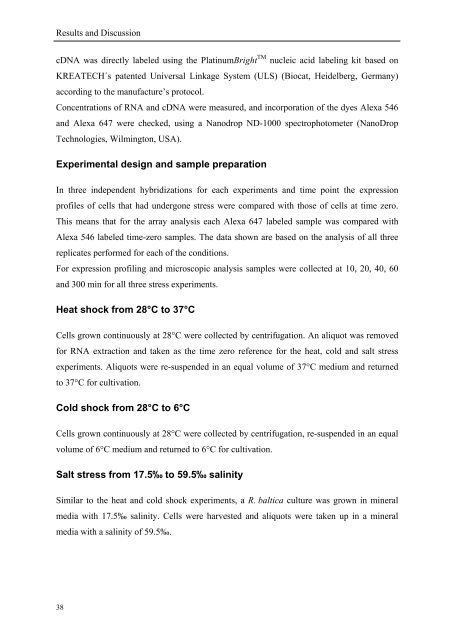a Whole Genome Array Approach - Jacobs University
a Whole Genome Array Approach - Jacobs University
a Whole Genome Array Approach - Jacobs University
Create successful ePaper yourself
Turn your PDF publications into a flip-book with our unique Google optimized e-Paper software.
Results and Discussion<br />
cDNA was directly labeled using the PlatinumBright TM nucleic acid labeling kit based on<br />
KREATECH´s patented Universal Linkage System (ULS) (Biocat, Heidelberg, Germany)<br />
according to the manufacture’s protocol.<br />
Concentrations of RNA and cDNA were measured, and incorporation of the dyes Alexa 546<br />
and Alexa 647 were checked, using a Nanodrop ND-1000 spectrophotometer (NanoDrop<br />
Technologies, Wilmington, USA).<br />
Experimental design and sample preparation<br />
In three independent hybridizations for each experiments and time point the expression<br />
profiles of cells that had undergone stress were compared with those of cells at time zero.<br />
This means that for the array analysis each Alexa 647 labeled sample was compared with<br />
Alexa 546 labeled time-zero samples. The data shown are based on the analysis of all three<br />
replicates performed for each of the conditions.<br />
For expression profiling and microscopic analysis samples were collected at 10, 20, 40, 60<br />
and 300 min for all three stress experiments.<br />
Heat shock from 28°C to 37°C<br />
Cells grown continuously at 28°C were collected by centrifugation. An aliquot was removed<br />
for RNA extraction and taken as the time zero reference for the heat, cold and salt stress<br />
experiments. Aliquots were re-suspended in an equal volume of 37°C medium and returned<br />
to 37°C for cultivation.<br />
Cold shock from 28°C to 6°C<br />
Cells grown continuously at 28°C were collected by centrifugation, re-suspended in an equal<br />
volume of 6°C medium and returned to 6°C for cultivation.<br />
Salt stress from 17.5‰ to 59.5‰ salinity<br />
Similar to the heat and cold shock experiments, a R. baltica culture was grown in mineral<br />
media with 17.5‰ salinity. Cells were harvested and aliquots were taken up in a mineral<br />
media with a salinity of 59.5‰.<br />
38

















